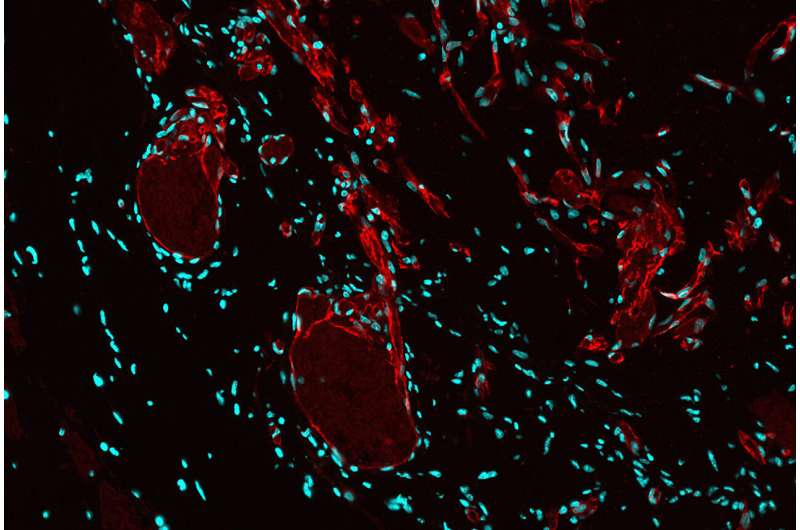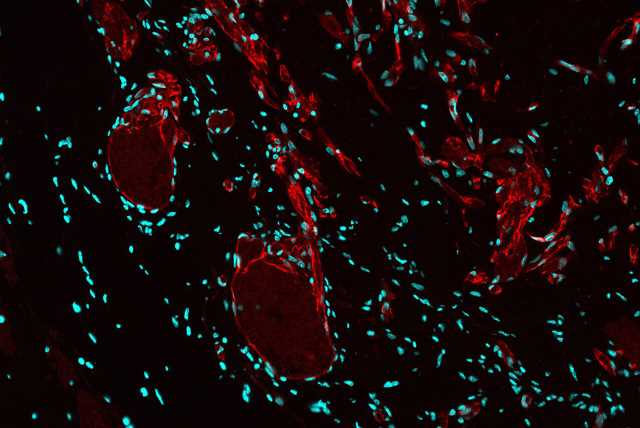Study demonstrates fibroblasts participate in the formation of vascular malformations—a potential new target for therapy

A study by researchers and clinicians at the University of Eastern Finland and Helsinki University Hospital provides novel insight into the previously unknown effects of fibroblasts in regulating blood vessel formation in vascular malformations. In the study, the researchers demonstrated that fibroblasts participated in the formation of venous malformations. Drug therapy with afatinib, an ErbB inhibitor, resulted in reduced lesion volume. The findings could be used in developing treatments for vascular malformations with a fibrous component.
Sporadic venous malformation and angiomatosis of soft tissue are vascular anomalies that affect venous vasculature and form benign lesions, which do not spontaneously regress. Symptoms include motility disturbances, edema, muscle weakness and pain, but lesions can also cause life-threatening bleeding or disfigurement, depending on location and size.
The first-line treatment for symptomatic venous malformation is percutaneous sclerotherapy, in which a sclerosant is injected into the affected vessels to cause fibrosis and blockage of the veins, thus alleviating the symptoms.
Angiomatosis of soft tissue is instead treated with surgical resection. Lesions, however, often reoccur. At the moment, no EMA-approved pharmacological therapy exists for the treatment of venous malformation or angiomatosis of soft tissue.
Vascular malformations occur due to abnormal vascular development. Somatic or inherited mutations in endothelial cells lining the vessels are known to initiate lesion formation.
A new study by the University of Eastern Finland and Helsinki University Hospital demonstrates that besides endothelial cells, fibroblasts participate in lesion formation in vascular malformations. Fibroblasts are cells normally present in the connective tissue. They are known to play an important role in wound healing and inflammation but also shown to increase, e.g., tumor growth.
The study, openly accessible in eLife, was carried out in the Vascular Biology research group of Academy Research Fellow, Adjunct Professor Johanna Laakkonen at the A.I. Virtanen Institute for Molecular Sciences, University of Eastern Finland.
“More effective therapies are needed for the treatment of venous malformation and angiomatosis of soft tissue due to their high recurrence, possible functional impairment associated with invasive procedures or complications after sclerotherapy,” says Plastic Surgeon Pia Vuola from Helsinki University Hospital.
“Findings from this research improve our understanding of cell-cell communication in blood vessel formation in these vascular anomalies. The discoveries related to fibroblasts show, for the first time, that although vascular malformations have been thought to be solely endothelium-driven diseases, other cell types can affect lesion growth,” says Academy Research Fellow Johanna Laakkonen from the University of Eastern Finland.
The researchers showed that drug therapy with afatinib reduced the volume of venous lesions, indicating that in the future, besides endothelial cells, targeting of lesional fibroblasts could be beneficial in developing treatments for vascular anomalies. New drug therapies can be developed based on these findings.
Understanding how the cell types interact in vascular diseases is one of the central research interests of the Laakkonen research group. The goal is to implement these discoveries for improved treatment of cardiovascular diseases.
More information:
Suvi Jauhiainen et al, ErbB signaling is a potential therapeutic target for vascular lesions with fibrous component, eLife (2023). DOI: 10.7554/eLife.82543
Journal information:
eLife
Source: Read Full Article
